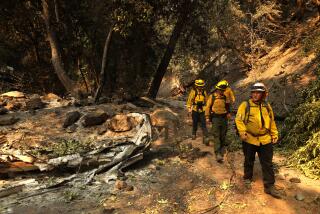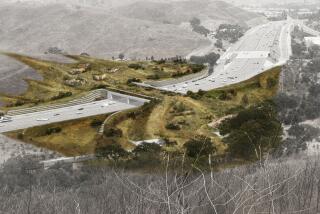A Span Without a Reason, Frozen in Time
If Rod Serling were inventing a bridge, this would be it: a two-lane highway span 4 1/2 miles from the nearest road. A bridge completed high in a rocky river gorge and all but forgotten for 66 years. A bridge of uncommon architectural elegance that has never carried a single car.
Government maps do not even show the single-arch span that crosses the East Fork of the San Gabriel River, deep in the Angeles National Forest. The Thomas Guide, however, does note the bridge along with its nickname--a name that Serling, the late “Twilight Zone” host, would have loved:
The Bridge to Nowhere.
“It’s a shock when you see it, it seems so far out of place,” says veteran hiker and wilderness writer John W. Robinson, whose book, “The San Gabriels,” recounts the ill-fated attempt to forge a road through the forbidding terrain.
The project, begun in 1929, took nearly a decade. Los Angeles County highway engineers relied heavily on prison labor to dig and blast the snaking route along the East Fork’s steep canyon walls, Robinson says. The low-lying highway was intended as a new means of travel from the Los Angeles Basin to the ski resorts of Big Pines and Wrightwood. Running east of Angeles Crest Highway, it would have served Azusa, Irwindale and other towns of the San Gabriel Valley.
At the Narrows of the East Fork, engineers encountered the steepest river gorge in Southern California--a V-shaped cut between Mt. Baden-Powell (elevation 9,400 feet) and Iron Mountain (8,000 feet). Pine-covered ridges conceal the mountaintops, but the vertical feel of the space makes it daunting and breathtaking.
The concrete bridge was constructed across the lower part of the chasm even while roadway work was underway. The bridge extends about 230 feet from a heavy rock buttress on one end to a steep ridge on the other. From the concrete balustrade you can peer down more than 100 feet to the rocky churn of the rapids.
Downpour Doomed Highway Project
Stamped on the end of the balustrade is a date: 1936. The bridge had yet to open--the highway was still under construction--when Los Angeles was hit by a so-called 100-year downpour.
“The great storm of the night of March 2, 1938 ... the biggest storm of the 20th century,” says Robinson, who was in grammar school at the time. He would later, as part of his research, examine the swelling of the East Fork from its normal depth--2 or 3 feet--to a torrent 30 or 40 feet high.
“It brought down boulders as big as garages. It washed out hundreds of [miners’] cabins--anything that was close to the stream,” he says.
Evidently, no one kept rainfall totals deep in the forest, Robinson says. But the storm ascending over the mountains probably resulted in twice or three times the deluge that fell in the city, he figures.
Heavy snowpack melted by the relatively warm rains also may have contributed to the flood, says Glen Owens of the Big Santa Anita Historical Society.
After the skies cleared, the road was so broken up and washed out the county decided to abandon it. Only the bridge remained intact, along with a tunnel through the ridge immediately north of it.
Some years later, the county sealed the tunnel--apparently because of liability concerns--and ceased maintenance of the bridge. What it cost to build, who designed it and even its exact dimensions are lost to the historical record.
“We’re really not dealing with the bridge anymore,” says Ken Pellman, a spokesman for the county Department of Public Works. “We vacated it a long time ago.”
A few short chunks of the bridge railing have fallen away, but otherwise it’s in remarkably pristine condition. The roadbed is not only uncracked but unmarked. Builders had yet to even paint the yellow stripe down the center.
The design is characteristic of other notable bridges of the era: The main arch is formed of two closely set parallel arches joined by short spokes. Columns are arranged the same way, in identical linked pairs, creating a fine latticed appearance also evident at the more-famous Colorado Street Bridge, constructed in 1913 in Pasadena, and the Bixby Creek Bridge, finished in 1931 on California 1 south of Carmel.
“What stood out in my mind,” says Gene Mezereny, who hiked to the Bridge to Nowhere recently, “was how well it blends into the surrounding landscape.” He voices a love of those old arch bridges, which he says look so beautiful compared with “the concrete monstrosities you see nowadays.”
Mezereny, a longtime outdoorsman who has visited the bridge half a dozen times, says he has noticed comparable lines in the rock formations of Utah’s Natural Bridges National Monument.
“There’s one [sandstone formation] I’ve been to several times ... that’s similar in shade and texture,” he says. “It’s a bit of a stretch, but as far as the arch of the bridge [is concerned], it has a similar look and feel.”
Finding the bridge is easy--you just follow the river north from the ranger station on East Fork Road. But the nine-mile round trip is an all-day journey. For stretches, the trail disappears and you walk on the rocks and push through brush.
There are stands of alder and sycamore, towering yuccas, banks of scrub and sage. Here and there the precipitous bank contains broken ledges of asphalt left over from the road project. Where immense boulders and rock faces make one side of the river impassable, you have to cross and continue up the other flank.
Inaccessible During Rainy Season
I hiked in December and had to make 10 crossings before reaching the bridge. Now that the rains are swelling the rapids, rangers advise against making the trek at all.
A bullet-riddled metal sign marks a rise in the trail just before the bridge. It warns against loitering, hunting, prospecting or bungee jumping. For a time, before authorities cracked down, the bridge was a popular bungee-jumping location.
Owens, the historian, has hiked to the bridge by traveling south from Angeles Crest Highway. From that direction, the bridge comes fully into view at once--a startling sight that, to Owens, mars the beauty of the Narrows. He calls the bridge a monument to man’s defeat by the forces of nature.
Robinson, the author, more bluntly labels the bridge a monument to man’s folly. He has tried to research the bridge’s name. The original name--if there was one--is also apparently lost to the record.
As far as he can tell, the new appellation may have surfaced in the 1950s. “By the 1960s, it was an established name,” he says. “I don’t know who first thought of it. It just sort of appeared. Everybody calls it the Bridge to Nowhere.”
More to Read
Sign up for The Wild
We’ll help you find the best places to hike, bike and run, as well as the perfect silent spots for meditation and yoga.
You may occasionally receive promotional content from the Los Angeles Times.






